|
HEENAN BEDDOWS AND STURMEY LTD. CROWN WORKS,
CLEMSON STREET, WILLENHALL
See Beddows and Sturmey Ltd.
THOMAS HERBERT AND CO. (WILLENHALL) LTD. EXCEL
WORKS, CEMETERY ROAD, NORTH WILLENHALL
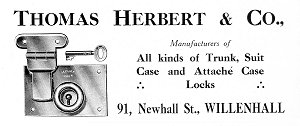 |
Makers of attache case and suit case locks.
Not existing in 1900 (Kelly’s). In Kelly’s directory of 1914
/21 listed at Newhall Street. Advert (left) from 1920. Later
moved to Cemetery Road. |
In the 14 November 1969 were acquired by Samuel Wilkes
and Sons Ltd (q.v.). Trading was transferred to the parent company
on the 1 January 1973.
The information above was in Jim Evan's original version of this
Gazetteer. We have now heard from George Cooper, in New Zealand,
who has been researching his family history. His findings so far
are of interest in themselves but also as an indication of the
complexity of relationships which can be found in small family firms.
George writes:
John Bucknall was born in Newcastle under Lyme in
1785. The Bucknall family
moved from Newcastle under Lyme.
John Bucknall, described as a locksmith, married Hannah
Mothershaw at St Peter’s Wolverhampton in 1806.
In a Willenhall Directory of 1818 he is listed as a pad lock maker in
Botany Bay. By 1835 he was in Pigot's directory as a pad and
closet lock maker in Birmingham Street. He was still alive
at the time of the 1851 Census in which he is listed as a locksmith in
King Street.
He died in 1865.
John and Hannah had three sons. The eldest,
William, was born in 1808 and is in Jones' Iron District Registry, 1864,
as a keymaker in Russell Street.
Another son, Thomas Bucknall, was aged 39 in the
1851 Census and is listed as a rim lock maker. He is listed in Jones’
directory as a lock manufacturer in Russell Street.
His brother, Samuel, is also listed as a park gate lock
manufacturer.
Thomas’s son, Edward Bucknall, was a Willenhall
Lockmaker.
Florence Bucknall married Leigh Richmond Clinton in
1890.
The Clintons were hairdressers in Market Street, Willenghall, the
business having been established by
Leigh’s father, James Clinton, in the 1860s.
Florence and Leigh Clinton’s daughter, Florence
Daisy Clinton, was born in Willenhall in 1895.
She remembered that her grandfather, Edward Bucknall, had a small
business as a lockmaker.
Edward Bucknall died in 1926, aged 82.
In his will, made in 1913, he appointed his sons, George Herbert
Bucknall and Thomas Bucknall, as his executors.
He left everything to his unmarried daughter Lydia and his
youngest son Bertie Lee Bucknall; but if either of them predeceased him,
then their shares to go to George and Thomas.
Florence spoke of her uncle’s business as “Thomas
Herbert’s”. The Willenhall
Red Book mentions Thomas Herbert as lock manufacturers in Cemetery Road,
in their 1929, 1933 and 1934 editions. The factory in Cemetery Road was
housed in an old Primitive Methodist chapel and two houses. The company
became well-known manufacturers of travel bag and brief case locks in
brass and steel, and was later
purchased by Wiggin & Company of Bloxwich. The buildings have long been
demolished.
Although this gives a clear connection between the
Bucknalls, the Clintons and Thomas Herbert's, the exact nature of that
relationship is not absolutely clear. There may also be a
connection with the firm Bucknall and Nevill Ltd. (qv).
In addition to George and Thomas, Edward Bucknall
had another son, Edward. Both Thomas and Edward were listed in the
1901 census as carpet bag lock makers, working on their own account and
both living in Walsall Road, Willenhall.
Edward is shown in the Ellis Island records as
entering the USA in August 1912. He gave his next of kin as Mrs.
Bucknall of Highfield House, Gypsy Lane, Willenhall and his occupation
as lockmaker. He said that he was going to a friend in Pittsburgh.
No further references to him in the USA have been found and he
resurfaces in Ventnor, Isle of Wight. His former wife, Harriet,
died in 1928 and he immediately married Nellie Dilke in London.
Nellie was 18 years younger than him. They had a substantial house
in Ventnor, Warborough Mount, which is still standing; and they owned
the local Bijou cinema, a thatched cottage in the High Street and other
property.
Edward died, aged 57, in 1930. His obituary
in the Isle of Wight Mercury says: "Resident since the war, a native of
Wolverhampton, he was the chief partner in a firm of lockmakers in
Wolverhampton, came here for health reasons after marrying a local
lady". Nellie lived until 1967. Her obituary includes the
following: " Widow of Edward Bucknall, at one time they owned
considerable property in Ventnor". Edward's will shows that he
left over £10,000, a lot of money in 1930.
HICKIN AND BAKER, HORSELEY FIELDS, WOLVERHAMPTON
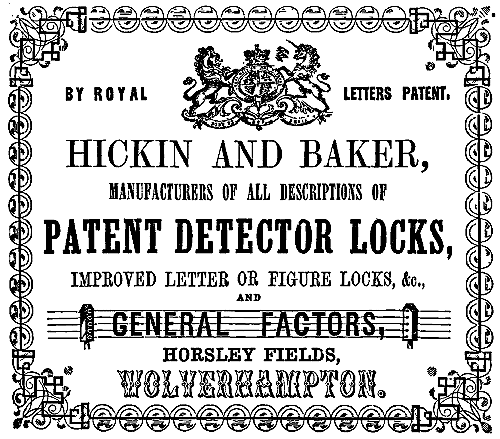
An advert from 1851.
JOHN HIGHFIELD, FAULKLAND STREET,
WOLVERHAMPTON
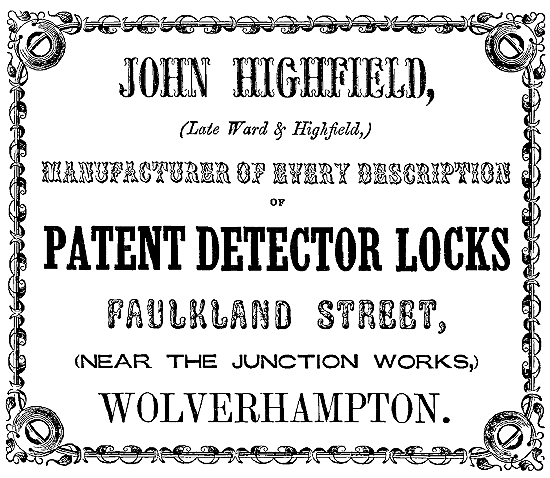
An advert from 1851.
|
HOBBS HART AND CO. LTD. STAFFA ROAD,
LEYTON
Makers of "Lever" and "Patent Protector" locks for all
purposes.
Alfred C. Hobbs was an American who came to England in
1851 as a salesman with Day and Newell when they came to exhibit at the
Crystal Palace Exhibition. He had also become an acknowledged
master at picking locks and took on the challenge of picking a Bramah
padlock. It took him 51 hours in 16 working days, after which he
could open the lock in an hour. The Arbitrators awarded him the
prize of 200 guineas.
With this money, and the invaluable publicity he had
received, he went into business as a lockmaker at 76 Cheapside, London. The company started in 1851 and was formally registered as Hobbs and Co.
in 1852. But by 1855 it had become Hobbs, Ashley and Company. Soon the name changed to Hobbs, Ashley and Fortescue, with an address at
97 Cheapside. They
used advanced machine methods and were highly successful.
In 1860 Hobbs returned to America and went on to patent
many machines. Before he left, British pride was somewhat restored
when one of the Chubb workmen picked a Hobbs Lock.
|
|
Hobbs had never
intended to stay in England and, when Ashley died in1860, he had no
difficulty in disposing of a thriving business to John Mathias Hart.
It is not known if Hobbs was any relation to Thomas Hart or if
either were related to William Albert Hart, who was a director from 1908
to 1910.
Hobbs had stipulated that his name should always
head the Company so it became Hobbs, Hart and Co. in 1860.
Hart died in 1887 and the firm became a limited company.
Hobbs retained an interest in the company: he returned in 1872
to celebrate the 21st
anniversary, held at the Crystal Palace which had, by then, been moved
to Sydenham.
Alfred Hobbs died in 1891.
The company is listed in Whitaker's 1914 Red
Book of Commerce as manufacturers of locks, safes and doors,
specialising in locks and lock furniture, combination bolts,
strong rooms and bullion vaults, fire resisting bullion and
jewel safes, and wrought iron and steel doors.
|
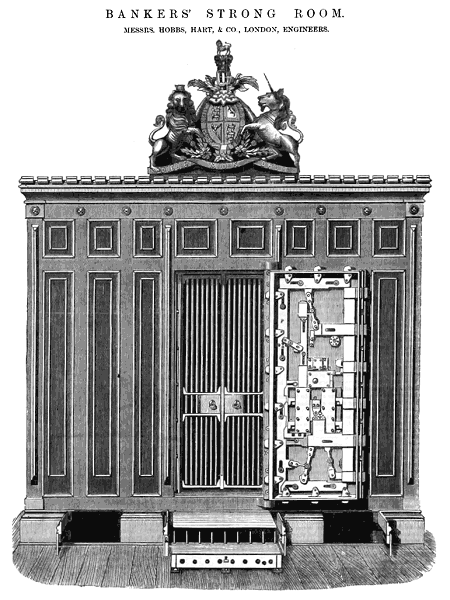
An advert from 1875. |
According to Peter Cowie (Locks and Keys, July 1995) the
company became a member of the Chubb group in 1954. But Peter Gunn
writes to us that "according to my information Chubb took over in 1956.
When I transferred to Chubb's Lock Sales Department in 1968, there were
still 2 or 3 ex-Hobbs employees working at Chubb Head Office, handling
enquiries for Hobbs locks. Chubb kept the Leyton factory going
until about 1961, after which manufacture of Hobbs products was
transferred to the Chubb Lock Works in Wolverhampton".
The following is a description of Hobbs & Company's products
that were on display at the International Exhibition of 1862 in
South Kensington:
Hobbs & Company, 76
Cheapside, E.C. Locks, patent & machine made and door lock
fastenings.
The exhibitors are inventors, patentees and
manufacturers of bank, protector, and other locks, and the
lock-making steam machinery. Hobbs's locks have been awarded the
following testimonials in their various competitions:- The Prize
Medal of the Great Exhibition of London, 1851; the First Class
Medal of the Imperial Exposition of Paris, 1855; the Gold Medal
of the Imperial National Mechanics' Institute of Vienna. In
addition to these, are two gold and three silver medals from
Various associations for the promotion of mechanical science in
the United States of America. The locks exhibited on the stand
to the right hand of the visitor, consist of the changeable key
bank lock and the protector locks.
Hobbs & Company's Patent
Parautoptic or Bank Lock.
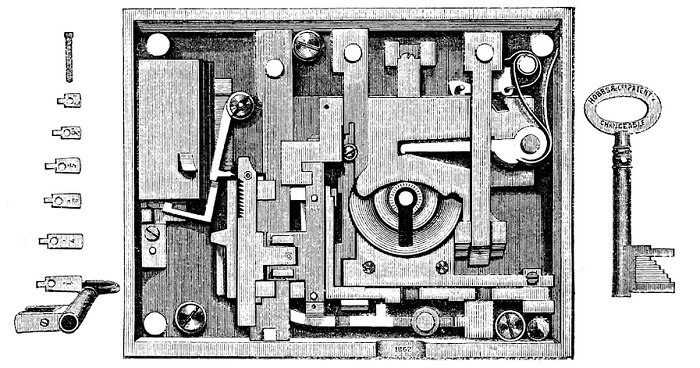
This lock, of which an illustration is
included, is deemed unapproachable as a security of the
repositories of treasure, and impregnable against every
practicable method of picking, fraud, or violence. The "bits" or
steps on the "web" of the key, that act on the levers inside the
lock, are separate, instead of being, as in other keys, cut on
the solid metal. These movable bits are fastened by a small
screw on the end of the shank of the key, when it has the
appearance of any other lever-lock key. There are besides, spare
bits to change, when desirable.
The lock has three sets of levers, and is
so constructed that, whatever arrangement the bits on the key
may have when acting on the lock, the latter immediately adapts
itself to the same arrangement, and will lock and unlock with
perfect facility; but it cannot be unlocked by any formation of
the "bits" except that which locked it. Let it be supposed that
the lock works with a "12- bitted" key, in proper numerical
order, as 1, 2, 8, etc. up to 12. The bolt is shot by them, and
will open by them; but if a bit is changed in its place, the
lock will remain locked, because, by the alteration, the key has
become also changed in its action, to which change the levers
will not answer. To re-lock in another form:- Suppose that,
instead of the bits being arranged as 1, 2, 3, &c. the order is
reversed, and they are screwed on as 12, 11, 10, etc down to 1.
By the self-changing principle of the lock,
it assumes the new form of the key, and will work with it as
readily and securely as it did before. The same results can be
obtained by any and every permutation of the number of "bits" of
which the key is composed, until millions, and thousands of
millions of changes are worked, every change virtually
converting the lock into a fresh lock by this simple
transposition of the key. Hence its name of "Parautoptic," or
changeable.
The illustration represents a view of the
lock, the key, and the spare "bits." To give an idea of the
number of times this lock can be transposed, it may be
mentioned, that a key of only six bits can be altered 120 times;
and if two sets of bits are used, the transpositions extend to
many thousands. The price of locks for bullion safes, and the
doors of strong rooms, etc. of which the above is an
illustration, is £20; and for cash and despatch boxes, and
similar purposes, £10. The keys can be made sufficiently small,
if desired, either for the waistcoat pocket or the travelling
case. It is claimed for both locks and keys that they illustrate
the highest degree of scientific and mechanical skill in the
locksmith's art.
Hobbs & Company's Patent
Protector Solid Key and Index Locks.
The patent protector locks are exhibited as
possessing absolute security against picking by any method at
present known. The key is what is called "solid," that is, that
the "bits" or "steps" are cut on the solid metal of the "web,"
and, therefore, not changeable. They are specially adapted for
places where the most ample security against lock-picking is
required.
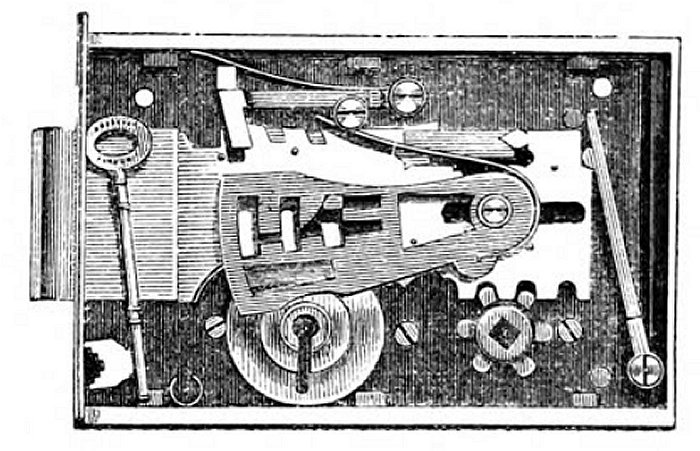
The "protectors" of this lock consist of a
peculiar arrangement of certain parts behind the bolt and
levers, unreachable by any lock-picking instrument whatever.
When any tampering is attempted on the lock, by pressure on the
bolt through the key-hole, to discover the opening position of
each lever, the bolt protector comes into action, preventing the
pressure affecting the layers in any way,
thus holding them clear, and thereby
frustrating the calculations of the thief. This principle was
first introduced in locks at the memorable Exhibition of 1851,
and forms the foundation of a new security. The key and bolt
fraud-protector is a movable nozzle, now first introduced. These
two protectors combined are offered to the public, as the two
essentials of security-protection against picking, and
protection against fraud. Specimens are shown illustrating the
action of the protectors. There is also a model showing the
arrangement of the bolts and locks as fixed on a strong room
door. The protector locks are sold, retail, at prices varying
from 10s. to 40s.
Hobbs & Company’s Patent
Lock Indicator.
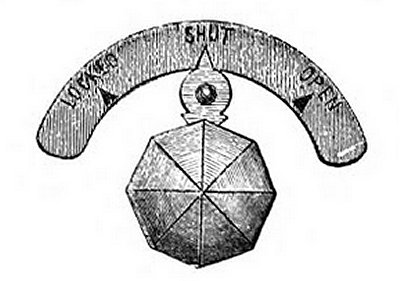
This is a method of locking the doors of
iron safes, strong rooms, customs stores, bonded vaults, prison
cells, corridors etc. by means of the handle, without a key, and
showing to what extent the bolt has been shot. It may consist of
the upper half of a dial upon which are the words, "Open,"
"Shut," "Locked." When the door stands merely closed to, the
index finger rests on "Open." This finger is fixed to the handle
that works the lock, and therefore, whichever way the handle
moves, the finger must move with it. Turn the handle, and fasten
the door by the first movement of the bolt, the finger will
point to "Shut." A second motion of the handle, and the bolt
shoots out beyond its reach, the finger at the same moment,
resting on "Locked." The lock can only be opened by the key
because at the second turn, the handle loses its control of the
bolt. The action of the bolt returning into the lock, or
unlocking, takes the index finger back to "Open," resetting it
again.
The advantages of this index in dockyards,
shipbuilders' stores, dock warehouses, prisons, etc. where
certain officers are limited to departments of the premises, by
day or night, must he of the highest importance. The superior
officer would be able, by its use, to see in an instant what
condition the bolts of the locks were in, without "trying" his
keys, as he passed along a corridor, or by a range of rooms.
Again, if the door of a safe or strong room was closed tight,
there would be no danger of leaving it unlocked by neglect, as a
glance at the index would show whether it had been locked or
not.

Specimens are also exhibited, showing the
application of the "lock index" principle to street door
latches, anti convict and other prison cells.
In the centre of the company's stand is a
first-class strong room door. It is made of the best iron-plate,
back and front, the interior being lined with slabs of hardened
steel. In this door the bolts are of the usual arrangement; they
are thrown by the knob, an examination of which will show the
great security attained by Hobbs and Co.'s patented method for
security. It will be seen to consist of triple security against
violence of all kinds, while the lock is peculiarly constructed
and is powder-proof, holding less than twenty grains of
gunpowder, which is totally insufficient to blow it off. |
J. HOBLEY & CO. 16 RILEY STREET,
WILLENHALL
Established in 1912 as lock and latch manufacturers.
In 1933 Randle Hobley had a lock making business in Church Street
Willenhall. Closed down c1970 when the last Mr Hobley died.
HODGES LOCK AND PRESSINGS LTD. FREDERICK
STREET, WOLVERHAMPTON
Established in 1860 as cabinet lock makers. Later
progressed into combination and brief case locks. In 1921 and 1936
James Hodges and Sons were cabinet lock makers at 27 Pool Street
Wolverhampton. In 1953 and 1972 they were at Frederick Street,
Wolverhampton, and were run by Mr Lisle, a grandson of Edward Lisle, who
built Star motorcycles and cars in Wolverhampton. On 15 November 1971
they were acquired by Samuel Wilkes and Sons Ltd (q.v.).
 |
In October 1974, as a result of continued expansion,
Hodges moved their factory to larger premises occupying 24000 sq.
ft. at the rear of the parent company, S.Wilkes and Sons Ltd., at
Park Road Bloxwich. |
Trading was transferred to the parent company on 1
January 1978. They went into liquidation in 1979 and the
manufacturing rights were acquired by Liston Locks Ltd (qv).
R. HODSON AND SONS, 54 NEW ROAD, WILLENHALL
Manufacturers of padlocks, park gate and lighter
locks; and double bolted and bar locks.
The business was established by Richard Hodson
(1780-1829) in 1792, in Clarks Lane, Willenhall. It was then taken over
by his son Richard (1811-1866) who, in the 1841 census, is listed as a
lockmaker at John Street. There were 4 apprentices living with the
family. By 1851 they were at Hall Street. Richard and his
wife Ann (1807-1865) had 7 children, including Edgar (1830-1891) who is
listed as a locksmith, and they had 4 apprentices living with them.
But by 1861 they only had 2 apprentices. On the death of his
father, Edgar inherited the business, which he ran until he died in
1891.

An advert from 1851.
Edgar’s son John (born 1861) became the owner in 1893,
paying £47.1s.6d. for "the shop tools, effects and the business" from
his late mother’s estate. The business at this time was run from
79 Lower Lichfield Street. John continued to trade under the name
Richard Hodson and Sons, and ran the business from several addresses
around Willenhall, finally, in 1903, moving into workshops at the rear
of 54 New Road. Here he employed up to a dozen men and women.
He rented the workshop from Mr Job Phillips, who at that time lived in
the house. When Job Phillips decided to sell the house and
workshop in 1905, John, and wife Sarah, seeing the chance to have home
and business on the same premises, decided to buy the property.
They had six children in all.
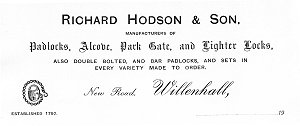 |
John died in 1911 and his son Edgar, aged only 19,
took over the running of the business, helped by his mother Sarah
and his sisters Edith (born 1891) and Flora (born 1899). The
sisters later set up in the front room of the house, running a small
drapers and general stores as E. A. & F. S. Hodson. |
Sarah died in 1951 age 91, leaving the
house to Edgar, Edith and Flora, none of whom ever married. The
two sisters devoted themselves to looking after their brother, the shop
and the house. In 1966 Edith died aged 75. Edgar continued his
lock making business into the sixties, until his death in 1970 aged 78.
Flora, the last member of the family, lived there alone until she died
in 1983 aged 84.
It was in 1983 that 54 New Road was purchased by the
Lock Museum Trust to be turned into a lock museum. The Lock
Museum, Willenhall was officially opened to the public in April 1987.
(Details taken from "The Hodson Family, A History of
one Willenhall Lock Manufacturer from 1972-1970" Compiled by Brenda
Jepcott. Published by The Lock Museum, Willenhall 1999)
| Visit the
Lock Smith's House and its buildings |
 |
S. HOGGINS AND SON, 57 NEW HALL
STREET, WILLENHALL
| Manufacturer of cabinet, rim, and mortice locks, latches,
padlocks, builders' ironmongery, and press work. Not
existing in 1921 or 1970. Nothing else known. |
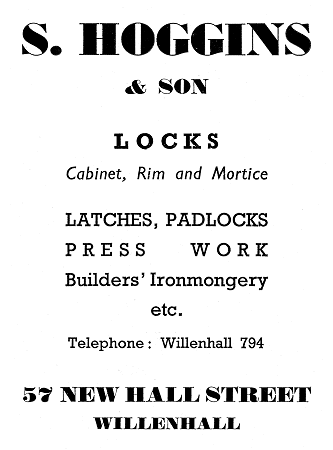
An advert from 1954. |
ARTHUR HOUGH AND SONS LTD. HILTON CROSS, CANNOCK ROAD, FEATHERSTONE,
STAFFS.
Arthur Hough was born in 1860 and, when he left school, went to work
for a key maker. When Arthur reached the age of 21 his employer
was unable to pay him a craftsman’s wage and Arthur had to look for
work. So in 1881 he set up on his own as a key maker in an
out-house behind his parents' home in New Invention, so founding the
keymaking business that bore his name. He would buy key castings
from a local foundry and finish them, mainly by filing, to supply to
local lock makers and factors to supply to the ironmonger for
replacement keys. Initially his brothers John and Henry joined him
until they both went on to found their own businesses.
Arthur quickly established himself in the trade and built a new home
for his family at No 1 Lichfield Road, New Invention, with a small
workshop behind it. His sons, Len and Tom, joined the business.
Tom died from gas poisoning, following service in the 1914-18 war, in
1926; by this time Arthur was employing his nephew, Reg Appleby.
Arthur and Len carried on making keys in a small way during the 1939-45
war. Len died in 1943 but, when the demand for keys started again
after the war, Arthur found that at the age of 65 he could not carry on
the business himself. He sold it to Reg Appleby, who was joined by
his brother in law, Horace Evans. As the business grew with the
post war boom in housing, and the demand for locks and keys increased,
they quickly needed more space and built a new factory in Brownshore
Lane, Essington where production commenced on the 15th March
1948.
In the 1950s the company started to produce keys by resistance
welding the parts of the key together, thereby doing away with the
laborious filing that had been a tradition of the key maker. This
produced a far more accurate key, which suited the need of the growing
lock industry with its production line assembly. Over the years
the factory grew in size and in 1970 the company extended their business
by installing machinery to produce wire and strip formed components, and
became the major supplier of accessories to the suspended ceiling
trade.
In 2003 Jim Evans, the original compiler of this gazetteer, and
Chairman of the company, passed away. His son, Richard Evans, took
over. The company is still a family owned business, with the
production of keys and suspended ceiling and partition products still
forming the major lines of buisness. In 2004 the company announced
that it was moving to a new 30,000 sq.ft. factory at Hilton Cross,
Cannock Road, Featherstone.
For further information see "100 years of Keymaking", and "100 Years
plus of Key making".
HENRY HOUGH, BLOXWICH ROAD, WILLENHALL
JOHN HOUGH, BLOXWICH ROAD, WILLENHALL
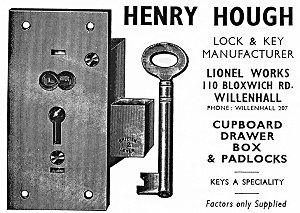
|
Henry Hough left school at 13 and worked above ground at a colliery as a
stores assistant. His father, also Henry, had been a miner.
Later Henry worked with his brother, Arthur, as a key maker but, in his
late twenties, he was an insurance representative, operating in the
Worcestershire.
Some time later he went back to work with Arthur as a key maker but
left in 1897 to set up on his own as a key maker in Bloxwich Road,
Willenhall.
|
He was on the opposite side of the road to another brother, John, who
was a lock maker. John Hough (1863-1946) had set up making brass
and iron cabinet locks, gas meter locks, padlocks, rim dead and mortice
locks in Bloxwich Road early in the 1890s.
| Around 1900 John built himself a workshop in
Henry's back garden. John and Henry combined their
businesses and traded as John Hough & Co. for many years.
Henry eldest son, Henry again, was the driving force there in
the 1930s and was accepted as the sole proprietor in 1944.
They continued trading as John Hough & Co. until about 1949.
They had a running contract with the Admiralty for 3" iron
padlocks and must have produced a few hundred thousand during
the war. |
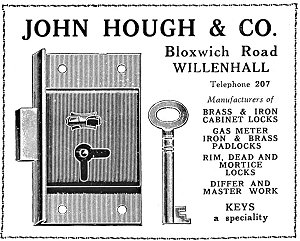
|
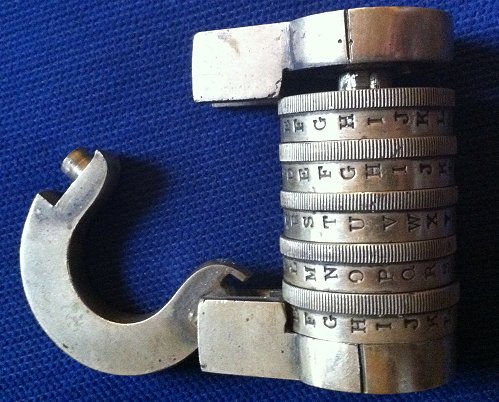 |
A fine combination padlock
made by John Hough. The
combination to open it was his surname.
Courtesy of James Hough. |
|
From 1950 onwards the firm concentrated on the
manufacture of brass cabinet locks for wooden furniture.
By 1952 the firm was trading as Henry Hough, Lionel
Works, 110 Bloxwich Road, Willenhall, manufacturers of cupboard, draw,
box and miscellaneous cabinet locks. Henry's son, David, a former art
teacher, joined the business in 1957.
Henry died, aged 56, in 1959. In 1961 David and
his mother, Leah, formed the company Henry Hough (Locks) Ltd.
In 1964 the firm moved to Love Lane, in Wem, Shropshire, where
productions just about trebled. In 1986 the business (the
means of production, the stock, expertise, etc.) was bought by
Walsall Locks (qv). |
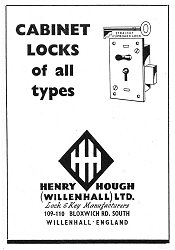
An advert from 1961,as seen in 'The Ironmongers' Diary.
Thanks to Trevor Dowson. |

(Information mainly from David Hough, 2002; and
also from Mr Jenkins of Wem 26/1/01)
HIATT LTD. BALTIMORE ROAD, GREAT BAR,
BIRMINGHAM
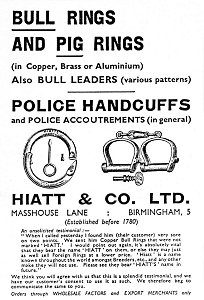 |
Founded in 1780. Manufacturers of handcuffs,
leg irons etc. In 1947 patented a screw key padlock.
In about 1997 branched out into selling imported locks and
hardware. |
GEORGE HUNT, JUN., ENTERPRISE WORKS, ORCHARD ROAD,
WILLENHALL
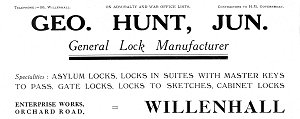 |
This advert dates from 1920.
In May 1950 the
business was sold to George Skidmore of Wolverhampton (qv).
Nothing else known. |
|